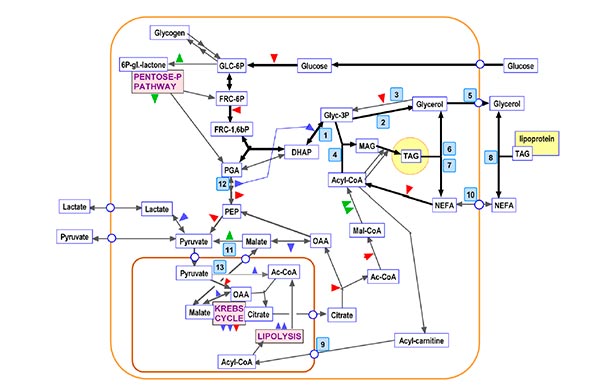Nitrogen-Obesity
Department of Biochemistry and Molecular Biomedicine
Faculty of Biology, UB
Xavier Remesar
ORCID: 0000-0002-9707-7287
Tel +34 934021518
Principal investigator: • Xavier Remesar
Emeritus Professor: • Marià Alemany
Researchers: • José Antonio Fernández López • Montserrat Esteve • Mª del Mar Grasa • Mª del Mar Romero (CIBER OBN) PhD student: • Laia Oliva

Current
Research
Metabolism of glucose in adipose tissue. Adipose cells use glucose (6C) to transform them into lactate or glycerol (3C). The fact that the fat tissue has all the metabolic machinery to produce urea can allow you to supply arginine, which can be used to generate NO ·, essential in the regulation of inflammatory processes. Our main objective are:
Determine how the use of glucose is regulated by adipose tissue cells, both adipocytes and stromal cells, and quantify the proportion in which each cell type intervenes.
How lactate and glycerol production is regulated.
Determine the effect of insulin on the use of glucose.
Check if the concentration of amino acids influences the metabolism of glucose.
Determine if the functionality of the tissue is modified by the effect of a high-fat diet as the cafeteria diet.
From the point of view of knowledge transfer, the TAB can represent an attractive therapeutic target for its ability to use glucose and thus reduce glucose avoiding the onset of metabolic syndrome
Activity of glucocorticoids in obesity. In people with morbid obesity, the activity of 11β-hydroxy-steroid dehydrogenase type 1 enzyme (11HSD1), in visceral adipose tissue can be a prognostic marker of weight loss in response to bariatric surgery.
Macrophages are susceptible to cortisone by action of 11HSD1 type 1, which promotes the conversion of foam cells in the presence of LDL oxidation as cortisol, in a dose-dependent manner.
11HSD1 activity is the true determinant of the final activity of cortisol in the body and that stress is a key factor in the initiation and / or maintenance of obesity. In obese patients, the search for a representative biomarker would allow simple monitoring of the glucocorticoid status of the organism and evaluate their response to different therapies aimed at reducing stress on the one hand, and involvement in failure or reduction of success of obesity therapies. For all this, our great challenge is to identify this possible biomarker, focusing on 11HSD1 activity in the fraction of polymorphonuclear blood cells (polymorphonuclear blood cells PMNBC), which can be obtained easily from the blood and which have already been revealed as sensitive and reflective of metabolic changes observed in obesity.

Selected
Publications
Remesar, X.; Fernández-López, J.A.; Alemany, M. Oleoyl-Estrone. Medicinal Research Reviews. 32(6), 1263-1291, 2012. doi.org/10.1002/med.20240
Romero, M. M.; Roy, S.; Pouillot, K.; Feito, M.; Esteve, M.; Grasa, M. M.; Fernández-López, J.A.; Alemany, M.; Remesar, X. Treatment of rats with a self-selected hyperlipidic diet, increases the lipid content of the main adipose tissue sites in a proportion similar to that of the lipids in the rest of organs and tissues. PLOS one. 9 (2): e90995, 2014. doi.org/10.1371/journal.pone.0090995
Ledda, A.; Gonzalez, M.; Gulfo, J.; Díaz Ludovico, I.; Ramella, N.; Toledo, J.; Garda, H.; Grasa, M.; Esteve, M. Decreased OxLDL uptake and cholesterol efflux in THP1 cells elicited by cortisol and by cortisone through 11b-hydroxysteroid dehydrogenase type 1. Atherosclerosis 250: 84-94, 2016. doi.org/10.1016/j.atherosclerosis.2016.04.020
Grasa, M. M.; Gulfo, J.; Camps, N.; Alcalá, R.; Monserrat, L.; Moreno-Navarrete, J. M.; Ortega, F. J.; Esteve, M.; Remesar, X.; Fernández-López, J. A.; Fernández-Real, J. M.; Alemany, M. Modulation of SHBG binding to testosterone and estradiol by sex and morbid obesity. European Journal of Endocrinology. 176 (4): 393-404, 2017. doi.org/10.1530/EJE-16-0834
Rotondo, F.; Ho-Palma, A. C.; Remesar, X.; Fernández-López, J. A.; Romero, M. M.; Alemany, M. Glycerol is synthesized and secreted by adipocytes to dispose of excess glucose, via glycerogenesis and increased acyl-glycerol turnover. Scientific Reports. 7: 8983, 2017. doi.org/10.1038/s41598-017-09450-4

Selected
Publications
Author
Identification
Remesar, X.; Fernández-López, J.A.; Alemany, M. (2012). Oleoyl-Estrone. Medicinal Research Reviews, 32(6), 1263-1291
[/su_spoiler] [su_spoiler title="" open="no" style="default" icon="plus" anchor="" class="selected-publications-toggle"]
Author
Identification
Romero, M.M.; Roy, S.; Pouillot, K.; Feito, M.; Esteve, M.; Grasa, M.M.; Fernández-López, J.A.; Alemany, M.; Remesar, X. (2014). Treatment of rats with a self-selected hyperlipidic diet, increases the lipid content of the main adipose tissue sites in a proportion similar to that of the lipids in the rest of organs and tissues. PLOS one, 9 (2): e90995
[/su_spoiler] [su_spoiler title="" open="no" style="default" icon="plus" anchor="" class="selected-publications-toggle"]
Author
Identification
Ledda, A.; Gonzalez, M.; Gulfo, J.; Díaz Ludovico, I.; Ramella, N.; Toledo, J.; Garda, H.; Grasa, M.; Esteve, M. Decreased OxLDL uptake and cholesterol efflux in THP1 cells elicited by cortisol and by cortisone through 11b-hydroxysteroid dehydrogenase type 1. Atherosclerosis 250: 84-94, 2016.
[/su_spoiler] [su_spoiler title="" open="no" style="default" icon="plus" anchor="" class="selected-publications-toggle"]
Author
Identification
Grasa,M.M.; Gulfo, J.; Camps, N.; Alcalá,R.; Monserrat,L.; Moreno-Navarrete,J.M.; Ortega,F.J.; Esteve,M.; Remesar,X.; Fernández-López,J.A.; Fernández-Real,J.M.;Alemany,M. Modulation of SHBG binding to testosterone and estradiol by sex and morbid obesity. European Journal of Endocrinology (2017) 176 (4): 393-404
[/su_spoiler] [su_spoiler title="" open="no" style="default" icon="plus" anchor="" class="selected-publications-toggle"]
Author
Identification
Rotondo,F.; Ho-Palma,A.C.; Remesar,X.; Fernández-López,J.A.; Romero,M.M.; Alemany,M. Glycerol is synthesized and secreted by adipocytes to dispose of excess glucose, via
glycerogenesis and increased acyl-glycerol turnover. Scientific Reports (2017) 7: 8983



